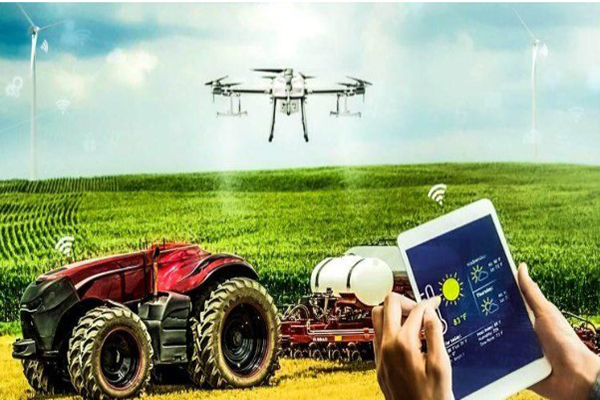Agriculture sector has been the back bone of any country’s wellbeing and economic growth for centuries. However, with growing population and urbanization, less interest of present and coming generations in hard work intensive agriculture sector, this sector needs lots of technological advances which can make the agriculture sustainable. The agricultural sector faces constraints in land and farming inputs, while the demand for food is growing at an unprecedented rate. The world’s population is expected to touch the 9.7 billion mark by 2050, and the water supply will fall 40% short of meeting global water demands by 2030. Some other food and sustainability issues plaguing the world are – rising energy, labor, and nutrient costs, reducing profit margins, degradation of arable land, and increasing environmental pressures, such as climate change and the economic impact resulting from it. To address these challenges, the agriculture sector must embrace modern technologies. Undoubtedly, more powerful and efficient machinery and genetic manipulation techniques have been available for a long time. Still, the changing world needs modern and more sophisticated tools, like Artificial intelligence, analytics, connected sensors, and other emerging technologies.
It’s well known that due to the environmental awareness, quest for comfort and non-availability of agriculture working force, the adoption of advanced and modern technologies is accelerating in agriculture sector. Machines today are more powerful, precise and easy to use than they have ever been, making them more efficient, productive and sustainable. Sustainability is top of mind for many businesses, and for agriculture, it is an opportunity to transform how we manage our natural resources to grow food and utilize food products. The development and usage of advanced technologies in the field of agriculture are occurring at a breakneck pace. The international scientific community has devoted a significant amount of resources and time to developing these technologies to increase yields, produce more nutritious crops, and promote long-term sustainability. In this article, we discuss state-of-the-art technologies as powerful and consistent tools for growth and development in the agriculture sector.
In real terms, that means finding innovative ways to reduce carbon emissions — in the plants where we build our machines and also during their usage — and developing methods to preserve the natural environment while maximizing productivity. All the technologies in use must have a sustainability impact, from automation and autonomous technologies to alternative fuels and electrification to advanced materials. That’s by increasing productivity, driving efficiency higher or reducing fuel consumption. The path to achieving our sustainability goals is one of continuous improvement. Whether it be decarbonizing within our own operations, within our value chain or related to our product portfolio, it’s technology advancements that progress us forward. Alternative powertrains, such as fully electric, hybrid electric and biofuels, are all viable solutions. They can reduce operations’ emissions while maintaining quality and productivity. There are further ways to meet the decarbonization challenge. We can manufacture our products with materials that have a lower emission impact for a higher level of recyclability, but also a higher level of end-of-life recyclability.
And precision technologies offer farmers innovative ways to lower their carbon footprint. Examples include improving water efficiency by using variable rate irrigation systems linked to real-time weather forecasts, which also take into account how the crop is growing. And pesticides can be applied precisely where they are needed. Advanced technologies can also preserve biodiversity which considers the interconnectedness between water risk, water scarcity, climate change and ecosystem. Using precision technology to minimize inputs supports the natural environment and contributes to healthier soils. Recently, systems like ‘sense and act’ have been developed which can be a key solution with a multispectral camera and advanced artificial intelligence engine. This ‘sees’ the crop in front of the tractor and adjusts the fertilizer being applied in real time by visually measuring the crops’ nitrogen levels. This provides a new level of efficiency for farmers. It optimizes inputs according to crop status and demand through precise rate control at normal vehicle speeds. This provides a new level of field efficiency for the producer. Technologies like all-electric light utility tractor with a battery pack that can support a full day of operation are being developed as a viable alternative fuel solution for farmers looking to decarbonize.
Machines which highlight a tried and tested biofuels solution having expertise in capturing, repurposing and storing fugitive methane emissions for energy use. And when connected with machinery, they can dramatically reduce emissions to deliver a carbon-negative system that fully supports a circular economy. When electricity is generated from captured fugitive livestock methane, it can be used to power the tractor, the farm and even be sold back to the grid. Still, there are significant challenges or opportunities regarding advanced technology adoption. One adoption challenge around decarbonization is ensuring that the alternative fuel equipment can complete all the tasks on the farm. That’s why biomethane is such an attractive solution – it delivers the same power as a conventional diesel machine. Another challenge is variety what customers are aiming to produce. Because of this, there’s a great degree of variability in the solutions they’re looking for. They want to be sustainable, but all want to maximize their productivity and to satisfy this, we continually evaluate our portfolio.
For customers, price and availability are key. Installing and operating advanced technologies must come close to their current total cost of ownership and provide a significant return on investment. As accessibility to these fuels increases, so should the variety of equipment that can utilize them. Indeed, there is still an infrastructure challenge — whether that be recharging/fueling stations or biodigesters. Training and support, both for operators and our dealer partners, will also be needed to ensure a smooth transition to these new solutions. Promising technology advancements hold potential for sustainable agriculture and construction as artificial intelligence and machine learning technologies. Advanced sensors will make farming practices more efficient by controlling the volume of chemicals applied to fields. Manufacturers are also working on augmented and virtual reality. These solutions also accelerate product development times through virtual assembly and digital prototyping — and they can reduce our travel by enabling us to conduct virtual design reviews. It’s sustainability through reduction. They also enable remote diagnostics and mean field issues can be resolved quickly without having to wait for a technician to attend. There is also an increasing focus on electrifying implements and not just the vehicle. There’s a great opportunity there for further innovation, leading to increased productivity and sustainability.
Growing population, environmental factors, and the need for affordable yet high-quality food have caused the agriculture sector to integrate technology into farm operations slowly. It has a profound impact on-farm productivity and efficiency. Technology has reduced the amount of effort required for farming while giving a new push to long-term sustainability. Let us now take a deeper look at how modern technologies can deliver the next productivity leap and help farmers optimize yields, become sustainable, and improve profits.
Increased Productivity: Modern technology allows farmers to carry out several farm activities with less effort and less time. Advanced Tractors, AgRobots, such as -robotic harvesters and separators, automatic in-row weeders, and many more devices and technologies are being deployed in the fields to increase productivity. AI, machine learning (ML), and IoT sensors can provide real-time data for algorithms to increase the efficiency and productivity of farmers.
Crop protection from humans and animals: Technologies such as surveillance systems based on AI and ML can quickly identify animal or human breaches, alerting farmers immediately to take quick actions. For example, Twenty20 Solutions is an AI-ML-based surveillance system that can secure remote facilities by deterring trespassers using machine learning.
Real-time data to improve crop health: Advanced sensors and drones can collect critical farm data and even offer real-time video streaming. All this information and data can be analysed with the help of advanced analytics to analyse growth patterns for crops, obtain constraint-based advice for optimizing crop yields, and gain new insights into improving crop health and products.
Reduced wastage and more cost-savings: With the combination of machine learning, social condition data from sensors, 3D mapping, and drone-based data of soil, Agri scientists can now predict the yielding capacity of a soil for a given crop. This eliminates guesswork and leads to increased productivity, reduced wastage, and substantial cost savings.
Less reliance on human laborers: For large-scale agricultural businesses, shortage of qualified and skilled workers is a serious issue impacting their productivity and profits. But now, thanks to robotics and automation, they can cultivate acres of land while also providing an element of security. These robots are capable of performing several tasks, such as distributing fertilizer on each row of crops, which keep the operating costs low while improving field yields.
No supply chain roadblocks: The pandemic led to the widespread adoption of the track-and-trace system, which provides greater visibility and control across supply chains, thus reducing inventory shrinkage. A state-of-the-art track-and-trace system relies on advanced sensors to gain a more excellent knowledge of each shipment’s condition. They also leverage IoT sensors and RFID to streamline performance and improve efficiency.
Decide the optimal mix of pesticides for lesser pollution: AI applications, Intelligent sensors, and visual data streams from drones can help agri specialists to detect a field’s most infected areas. With this information in hand, farmers can decide the optimal mix of pesticides to control pests while reducing chemical pollution in fields.
Better pricing strategies with price forecasting: By understanding the quality levels of crops and yield rates, farmers can get the best possible price for their harvests. This way, agribusinesses, and farmers can save millions of dollars a year in lost revenue.
Efficient utilization of water resources: Water is one of the sparsest and most vital resources for farmers; therefore, its efficient utilization is every farmer’s utmost priority. It is so crucial that its efficient use can mean the difference between staying profitable or not. That said, advanced technologies, such as linear programming enable farmers to estimate the optimal amount of water a given field or crop will need. Machine learning algorithms can be used to estimate how much water fields and crops need to optimize yields.















